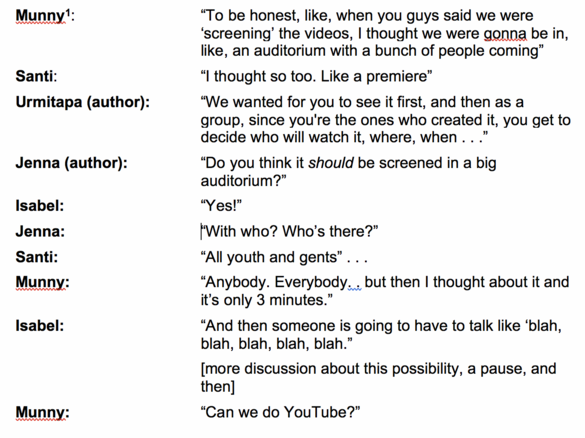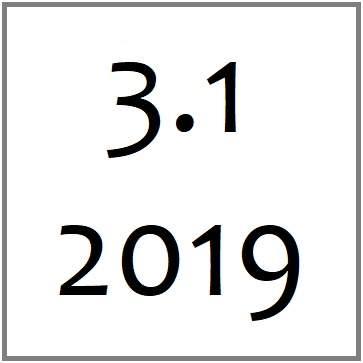Introduction
What does curation involve when guided by feminist, community-based participatory methodologies aimed toward social change? Participatory curation, or curatorial acts conducted by those in a participatory action research project, involves navigating tensions while striving to ensure that differently positioned participants have opportunities to voice their perspective on when, if, and how to exhibit/disseminate the co-created knowledge. Take, for example, this exchange between youth and adults during our community-based project:

Curation, we argue, is a way to name and critique these kinds of intermediary processes that are fundamental to community-based participatory and action research, yet relatively undertheorized. In other words, curation is a critically important intermediary rhetorical action in-and-of-itself when collaborating with participants from marginalized groups.
Many scholars agree that good community-engaged research is reciprocal, ethical, and driven by co-creation of new knowledges that respond to community-defined needs (“CCCC Statement” 2016; Licona & Gonzales, 2013; Royster, 2014). This aligns with participatory action research (PAR), an epistemic and methodological stance rooted in the principle that valid knowledge is produced through collaboration and action (Fals-Borda & Rahman, 1991; Fine, 2007; Lykes, 2013). A common call across these literatures is for researchers to be self-reflexive about how they engage participants to avoid exploiting already marginalized voices and ways of knowing to serve academic ends. This includes ethical concerns around who participates in the research process and who has the right to show and manage the products of the research collaboration. Considering this, we maintain that curation is the researchers’ opportunity to establish reciprocal, participatory creation of knowledge.
 This article offers a deeper understanding of the praxis of participatory curation. Specifically, we—two feminist activist scholars, a feminist rhetorician (Jenna) and a decolonial community psychologist (Urmitapa)—facilitated a PAR project to support marginalized youth in creating and presenting digital stories that highlight critical issues impacting their communities. Our community-engaged scholarship is firmly anchored in the values of activist scholarship as we actively resist and try to disrupt transactional, top down modes of community engagement that have increasingly come to characterize neoliberal institutions of higher education (Sudbury & Okazawa-Rey, 2009). At the same time, we are critically conscious of the power and politics of our community-engagement in a mid-sized city with a sprawling university campus and its ramifications on the wider community. Thus, we often refer to ourselves as university-affiliated researchers to index our power, resources, and inherent complicity in the uneven nature of university-community partnerships.
This article offers a deeper understanding of the praxis of participatory curation. Specifically, we—two feminist activist scholars, a feminist rhetorician (Jenna) and a decolonial community psychologist (Urmitapa)—facilitated a PAR project to support marginalized youth in creating and presenting digital stories that highlight critical issues impacting their communities. Our community-engaged scholarship is firmly anchored in the values of activist scholarship as we actively resist and try to disrupt transactional, top down modes of community engagement that have increasingly come to characterize neoliberal institutions of higher education (Sudbury & Okazawa-Rey, 2009). At the same time, we are critically conscious of the power and politics of our community-engagement in a mid-sized city with a sprawling university campus and its ramifications on the wider community. Thus, we often refer to ourselves as university-affiliated researchers to index our power, resources, and inherent complicity in the uneven nature of university-community partnerships.
In this article, we present two vignettes from the project capturing critical moments of curation:
- Vignette 1: The solicitation of shared narratives about youth’s experiences in their community
- Vignette 2: The public dissemination of the co-created digital stories
These vignettes are told through narratives from the youth storytellers reflecting on these processes, narratives from the university researchers explaining/theorizing the process, and images of the multimodal ways we engaged the curation process. Guided by feminist methodologies, we engage in a process of critical reflexivity on the role of curation in a participatory, action-oriented, community-based project (Fonow & Cook, 2005; Pillow, 2003; Royster & Kirsch, 2012; Visweswaran, 1994). For us, this means methodically asking the following throughout the process:
- What is being curated?
- What is “our” role?
- Who is the curator?
- To what end in terms of social change?
Grappling with these questions, we create this web-text to show how curatorial power shifts during the process of a creative-rhetorical community project like the creation of digital stories (see Reflexive Engagement 1 and Reflexive Engagement 2). At times we made the decisions, at times the youth did. It is not balanced or always shared in utopic ways, but it is mindful, attentive to the pragmatic needs of the youth program (or community site for others), and consistently resistive to the ivory tower regime of showcasing community to produce feel good moments for neoliberal universities but little else.
YOUTH DIGITAL STORYTELLING PROJECT / VIGNETTE 1 / REFLECTION ON VIGNETTE 1/ VIGNETTE 2 / REFLECTION ON VIGNETTE 2 / CONCLUDING REMARKS / REFERENCES
[1] Pseudonyms have been used for all youth participants.
